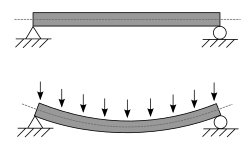Beams
 From Wikiversity - Reading time: 4 min
From Wikiversity - Reading time: 4 min
Part of the Statics course offered by the Division of Applied Mechanics, School of Engineering and the Engineering and Technology Portal
Lecture
[edit | edit source]Distributed forces are very common in the design and analysis of structures themselves, while point forces are often what structures are designed to withstand. The weight of a stationary car on a bridge should be interpreted as four point forces at the point of contact of each tire with the bridge, while the weight of a long train could be interpreted as a distributed force along the length of the train.
Center of Gravity (Mass)
[edit | edit source]The center of gravity (or mass), abbreviated as COM, of any object is that point within the object upon which gravity (or any body force) acts, regardless of the orientation of the object. The COM of an object may be calculated by using the principle of equilibrium.
, , (1)
In the event that the density of an object is not uniform throughout, the calculation of COM may be done by a similar set of equations involving the addition of density to the analysis.
, , (2)
If a body is made up of multiple sections, each of which has a unique mass, the method for evaluating the centroid of that body is to evaluate the composite body by finite element analysis of each of the sections through the use of moment balancing, as above.
, , (3)
Centroids
[edit | edit source]If a body has a uniform density, then as we may see in equation (2) above, the density cancels out, and we are left with a resulting COM that is determined as a geometric analysis and is called a centroid. The centroid of a volume may be calculated by the following equations. (Also see the List of Centroids on Wikipedia.)
, , (4)
Distributed Forces
[edit | edit source]
A distributed force is a force applied over a length, area or volume. A line-distributed force such as the weight of a bridge suspended off of a single tension wire, is measured in units of force per unit of length (Newtons/meter). An area-distributed force such as the weight of a ship's hull against the body of water it floats in, is measured in units of force per unit of area (Newtons/m2) and is referred to as pressure when associated with the force of water and stress when associated with the internal forces affecting solids (such as those invoked by tension or compression). A volume-distributed force such as the force of gravity affecting a mass within the gravity field of a celestial body, is measured in units of force per unit of volume (Newtons/m3) and is often called a body force. A distributed force, like any force, may be simplified into a resultant point force , which acts at the centroid of the function described by the resultant force .
Static Determinism
[edit | edit source]For beam loading calculations wherein the external forces may be calculated by using only the principle of equilibrium, such a beam or system of forces is called statically determinate. Any system whose resultant forces may not be calculated only through external forces and the principle of equilibrium, is called a statically indeterminate system, and must be solved through the additional analysis of internal forces and the deformations induced by them. Such systems often have more supports than are needed at minimum and may be tentatively identified as such (i.e. a beam with three supports instead of two).
Internal Forces
[edit | edit source]
Internal forces within beams come in three flavors. Moments (bending), Shears (cutting) and Torsion (twisting). Oddly, each of these forces may be derived in a related manner.
Vertical forces, and thus shear forces, may of course be evaluated by using the principle of equilibrium on a rigid body. All vertically aligned forces in the y-axis must sum to equal zero. The shear force may also be considered the integral of the loads in the vertical direction, or .
Similarly, moments may be evaluated by using the principle of equilibrium on a rigid body as well. However, bending moment may be evaluated as the integral of the shear force, that is to say . Thereby, moment is also the double integral of the load in the vertical direction or, .
Torsional forces in the opposite axis are to be evaluated in the same manner as bending moments, although care must be made not to confuse forces in other directions with those contributing to torsional stresses.
Bending
[edit | edit source]List of area moments of inertia
A bending beam is .
Assignments
[edit | edit source]Activities:
- Create an activity
Readings:
- Peruse the appropriate sections of b:Statics
- Introduction to Structural Design, Virginia Tech.
Study guide:
- Wikipedia article:Distributed force
- Wikipedia article:Center of mass
- Wikipedia article:Centroid
- Wikipedia article:List of centroids
- Wikipedia article:Pappus's centroid theorem
- Wikipedia article:Beam (structure)
- Wikipedia article:Beam theory
- Wikipedia article:Statically indeterminate
- Wikipedia article:Torsion
- Wikipedia article:Shear
- Wikipedia article:Bending
- Wikipedia article:List of area moments of inertia
 KSF
KSF

















